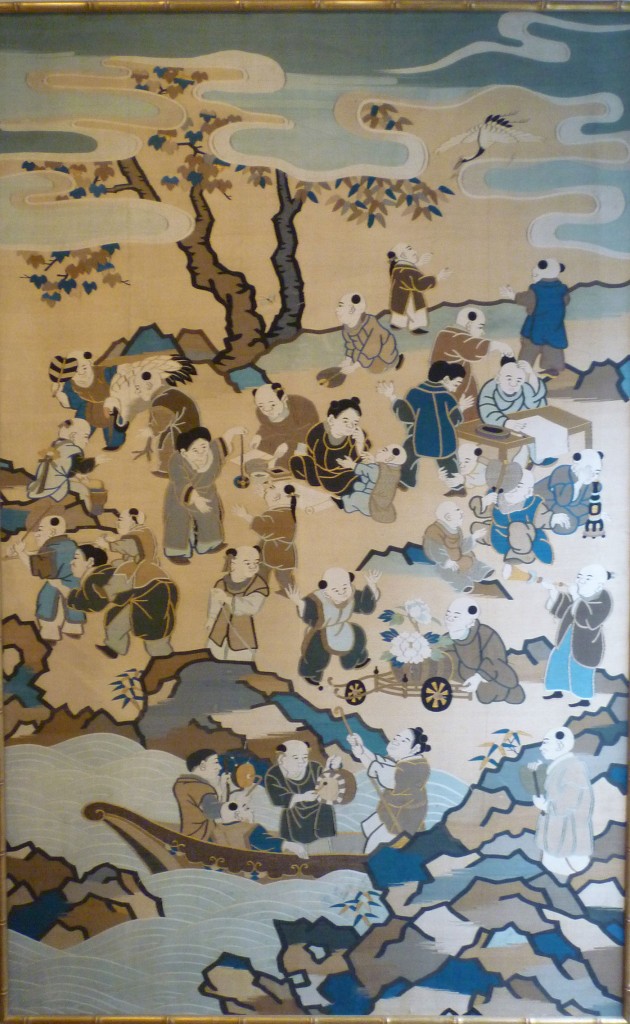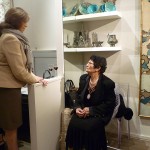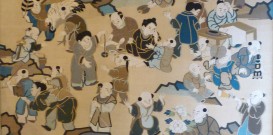Eastern
Eastern Treasures – Zadah Gallery Asian Art In London Exhibition
During the month of November (2011) the city of London became Asian, or at least those sectors concerned with antique and contemporary art did. Asian Art, a collective of Asian art societies, galleries, museums, and auction houses annually organizes a menu of events including major auctions, exhibitions, events, and sales. In keeping with this annual Asian invasion Zadah’s Antique Textiles Gallery hosted an exhibition, Eastern Treasures (curated by Sarah Haberkern) that treated us with an overview of textiles spanning most Asian regions. Zadah, who has built his reputation with numerous previous textile exhibitions, dipped into his family’s collection to augment this show’s Asian mission. One of these special treats was a pair of 17/18th century embroidered panels (see background in the ‘gallery team’ image below) with an impressive provenance having previously been in the collection of Tate Gallery’s founder, Sir Henry Tate.
The family subsequently donated the panels to a charity auction whereupon it entered the public domain only to disappear again into the Zadah family collection. The inspiration for this genre of textile, characterized by unusually refined realistic articulation, seems to be Dutch botanical lexica. Indeed trade between the two countries was well established at this time. The popularity of this style can be traced to the 4th Moghul Emperor, Jahangir, after his return from his royal gardens. This particular pair was probably woven specifically for export to the Netherlands where they were most likely employed as curtains. They are in an excellent state of preservation.
The opening of Easter Treasure was well attended by an enthusiastic group of appreciative visitors. In the course of the evening lively conversation and discourse on the material engendered new perspectives and discoveries. Topical stimulation was provided by exquisite kesis, outstanding Ming textiles, a beautiful Resht, and a group of Safavid textiles that adorned the gallery. Perhaps the most discussed textile was a Moghul summer carpet. These rare embroideries consist of elaborate flowers rendered in silk satin stitch and couched metal thread. This particular example, be it Goan or Deccan, is related to a similar example in the Victoria & Albert Museum. The V & A piece is said to have belonged to Tipu Sultan of Mysore, who died in the battle of Seringapatam in 1799. Typical for the type, both examples display an oval medallion with radiating flowering stems, quarter medallion corners, and borders with floral meanders.
The exhibition will be reviewed by HALI where perhaps you might out more about one the earliest Ghiordes rug and a beautiful West Anatolian rug that were included in the show.
Asian Art In London – Zadah’s Exhibition of Antique Eastern Rugs And Textiles
Antique Eastern Rugs And Textiles
Earlier this month, we held our ‘Eastern Treasures’ Exhibition, showing a unique selection of antique rugs and ancient textiles from the East.
We exhibited an exclusive selection of antique rugs and textiles, all connected through their Eastern origins – unique historical pieces from Japan, China, and India, to name but a few. You can see a fine example of Japanese craftsmanship, an 18th/19th Century Japanese Kesi in our blog. View our collection for other Eastern Rugs and Eastern Textiles.
Some of the antique eastern rugs were displayed for the very first time in the Zadah gallery. The Eastern Treasures exhibition took place as part of the Asian Art in London Event. Asian Art in London has been held since 1998 – a ten day event featuring the leading UK dealers and auction houses. Exhibitions are held at a select list of dealers in antique textiles, while auction houses like Sotheby’s, Bonham’s and Christie’s hold gallery talks and auctions, featuring antiques from the East which span 5,000 years of history.
Visitors who came to London during the week had the opportunity to view some of the best Asian Art in the world, from Imperial porcelain to contemporary art, in gallery selling exhibitions and auctions, together with lectures and symposia by London’s major museums. Asian Art in London, now in its 14th year, has an established reputation as one of the most important Asian art events on the international art calendar. Zadah are privileged to have taken part in the Asian Art in London exhibition for a number of years, showing select pieces from our collection – which itself contains pieces from all over the world – Eastern Textiles, European Tapestries, African Pieces, Islamic Antiquities and more, pieces covering almost 2000 years of history.
On the 3rd, we held an invitation-only opening for the Exhibition (we extended an invitation to the visitors to our website, perhaps you viewed the Exhibition – we would like to know what you thought), attended by dealers, antiques experts and textile historians, to name but a few.
Below, you can see a series of photographs from the opening, featuring some of our wonderful Eastern rugs – and some of our wonderful guests.
Our 18/19th Century Japanese Kesi – On Display During Our Eastern Treasures Exhibition
This Japanese kesi tells the story of the happy children. It is a myth and folk tale going back to Chinese traditions that were taken over by the Japanese. The children represent happiness, the innocence of the youth and fertility. The children all have different toys and attributes that represent the common arts of the time, such as music, painting, calligraphy and so on. The main statement of the picture is the wish for a long happy life that at that time was guaranteed by many children. It is also a good example of the accumulation of different folk traditions. The kesi can be dated 18th/19th century and shows only minor wear. The technique of the kesi textiles was imported from China. Kesi (silk tapestry weave) became the vehicle for quintessentially Chinese aesthetics during the Song Dynasty (960-1279) in textiles which feature traditional phoenix and peony motifs or which emulate styles of Chinese brush painting. During the Ming (1368-1644) and Qing (1644-1911) dynasties, court robes, rank badges, and Buddhist and Daoist Kesi were all used to denote status and wealth, as well as to express religious devotion.
This outstanding piece can be seen in Zadah’s exhibition “Eastern Treasures” opening on the 3rd of November. The exhibition is a part of the Asian Art in London event, a very exclusive circle of exhibitors which show their Asian collections from the 3rd till 12th November. Our opening takes place in 4 Marylebone Street at 6 to 9 pm.





